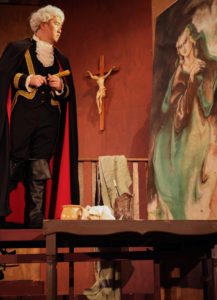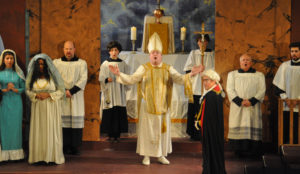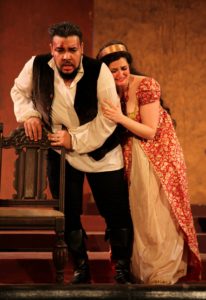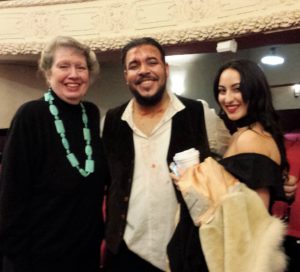Giacomo Puccini’s Tosca premiered on January 14, 1900 at the Costanzi Theatre in Rome. The critics were puzzled and one of them called it a “shabby little shocker”. As Bogart said to Bergman in the W.W. II film Casablanca “In this troubled world the problems of three little people don’t amount to a hill of beans”. That cannot be said of Tosca. The story of actress Floria Tosca, her revolutionary lover Mario Cavaradossi and the evil, hypocritical, lustful Chief of Police, Baron Scarpia will endure as long as opera exists!

Scarpia looking at Cavaradossi’s painting of Mary Magdalene. Photo by Sabrina Palladino
The Regina Opera presented this masterpiece on Saturday March 4th for a run of four performances over two weekends with two alternating casts. It should be noted that on March 4, 1913, Tosca was presented at the Brooklyn Academy of Music (The Metropolitan Opera on tour) with the peerless tenor Enrico Caruso as Cavaradossi, soprano Olive Fremstad as Tosca and baritone Antonio Scotti as Scarpia, with the great Arturo Toscanini conducting.
Needless to say, those opera legends surely would have been pleased to witness Tosca as presented by The Regina Opera in their 47th season, now at Our Lady of Perpetual Help Catholic Academy of Brooklyn theater (OLPH) in Sunset Park.
The lights dimmed and principal conductor, the gifted Maestro Gregory Ortega started the striking opening chords which instantly set the mood for the performance to come. Tosca, is based on a play by Michel Sardou, which was a vehicle for actress Sarah Bernhardt. The aging immortal Giuseppe Verdi wished he could have set it to music but Giacomo Puccini did! And this, his fifth opera, was one for the history books!

In the opera world, some performances are preceded by opera” buzz.” For the performance attended by this writer, it was about the tenor, José Heredia, who played the role of Mario Carvaradossi, a painter. Mr. Heredia’s singing of “Recondita armonia” was sung with sweetness and ringing power. This was a “full lyric” voice with a Pavarottian shimmer, sparkle and a very secure foundation. His jealousy duet with Tosca was done with humor and elan and a beautiful arched and cavernous upper register.
In Act Two, Cavaradossi (Heredia’s) defiance of Scarpia and his lackeys was strong and his cries of “Vittoria, vittoria!,” at the news that the Napoleonic forces had won a victory, rang through the theatre. In the final act his exquisite singing of “E lucevan le stelle” was opera magic. His spinning the notes, polishing the silverware so to speak, was of the highest order. The tragic lamentation of his final phrase won the hearts of the audience. No “grandstanding” – just singing “on the word” and articulating it with sweetness and fervor.
The final duet “O dolci mani” was a true heavenly blend, their voices bouncing off the walls with ardor and hope. Cavaradossi died well. My question is, did Mario Cavaradossi know that this “mock” execution was really going to be his death? He did not trust Scarpia.

The Tosca of the evening was soprano Megan Nielson. I was impressed with her YouTube offerings, but seeing and hearing her in person was vital and indelible. Her singing in the jealousy duet with her lover Cavaradossi was exceptional. Her combination of coyness and flare ups were adroitly handled and there were sudden vocal bursts of pure, almost Wagnerian gold. Tosca’s emergence from intimidated to defiant was gradual: she simply “could not and would not take it anymore!” When all seemed lost, her prayerful singing often on her knees of the famed aria “Vissi d’arte” was beautifully done. The top note “Signore” preceding the “Così” was ravishing. Tosca’s seeing and seizing the knife and her stabbing of Scarpia who was imploding with lust, giving him a bloody sampling of “Tosca’s kiss.” Her telling him to choke on his own blood as he begged for help was riveting. Tosca’s removal of the “safe conduct” papers for Cavaradossi was eerily heart pounding. Placing the candles on each side of Scarpia’s dead body and dropping the crucifix on his chest with the snare drum roll in the background, was gripping. Ms. Nielson’s dramatic utterance of “E avanti a lui, tremava tutta Roma” was snarled with sarcasm and dark sounding chest voice. Her red cape slithering as she left to find her Mario was another fine example of operatic gesture.
In the final act, Tosca’s relating the entire affair with some powerful notes led to their duet “O dolci mani”. Ms. Nielson’s blending and soaring tones were matched by her tenor José Heredia as they “shook the rafters” of the theatre. His death, her shock followed by her leap and singing of meeting Scarpia before God was unforgettable. (“O Scarpia, avanti a Dio”)

The role of Scarpia was in the hands and voice of Peter Hakjoon Kim. The role of the evil, lustful chief of Police Baron Scarpia suited him like a glove. His strong flexible baritone allowed him to put fear in the hearts of the beholders. His entrance in the Church of Sant’Andrea della Valle while the children and Sacristan were frolicking was worthy of the great actor Charles Laughton. His “Un tal baccano in chiesa” knocked you right out of your seat. His seeing Tosca, still smarting of jealousy, set his innards on fire. The religious procession that follows has Scarpia singing of his passion and lust for Tosca, vowing as he crosses himself that he would renounce God to posses Tosca. Kim’s singing reached dazzling heights as he stretches the vocal envelope to soar to the heavens from his hellish feelings. In the second act at the Palazzo Farnese, Scarpia is in full command. He demands the whereabouts of political prisoner Angelotti and has Cavaradossi tortured. Cavaradossi’s screams are unbearable to Tosca who relents.
Scarpia’s singing of “Ha più forte sapore” and “Gia…Mi dicon venal” explains his desires to cruelly conquer, lust without love, possession and dominance, filling oneself with wine and women. His battles with Tosca and the images of his sadism and cruelty and his ultimate demise at her hand made for great theater! Mr. Kim’s voice had a wonderful thrust to it and he can raise the decimal levels very well or sing lugubriously softly when needed. Bravo for Kim! A Scarpia we loved to hate. His “comeuppance” at her hand was most satisfactory.
Angelotti, a political prisoner, was ably played by Luis Alvarado. His basso was smooth and pleasing but a bit more desperation would have rounded out his character.
John Schenkel portrayed the Sacristan with great Italianate flair, his buffo baritone tones vividly portrayed comedy and drama, joy and fear, religiosity and mischief.

Spoletta, Scarpia’s agent, lackey and factotum was played with spidery assurance by Reuven Aristigueta Senger. Senger’s insinuating tenor and total compliance made him a Goebbel’s to Scarpia’s Hitler. Even Scarpia’s slapping him was accepted with a sense of joy that he would soon redeem himself. He was Igor to Dr. Frankenstein. When it is discovered that Scarpia has been killed and Tosca in flight jumps to her death, Spoletta does the sign of the cross. For whom? Himself? Tosca? Scarpia? The world as he knew it? The versatile Senger also played the part of the Judge.
Rick Agster was an efficient, cool Sciarrone. His plangent bass served as comfort food for the corrupt Baron Scarpia who needed efficient cruelty from his lackeys like roses need rain.
Jonathan R. Green was both the jailer and Roberti. His sonorous baritone calling of Mario Cavaradossi’s name before the execution helped create the somber mood.
Nomi Barkan was the off stage Shepard boy who sings a mournful song to the tone poem interlude at the start of the final act. Her alto voice was like a gentle breeze midst the bells and dawn.
Principal conductor Gregory Ortega kept the 33 splendid musicians of the Regina Orchestra at white hot inspiration. Scarpia’s entrance music in the first act was heart pounding and the fortissimo finale thrilled.

Special praise to the Barkan family. Diana Barkan on the violin, Dimitri Barkan on the oboe and their children Nomi Barkan age 9 and Shelley Barkan age 16 sharing the role of the Shepherd boy, and Vladimir Kozlov, violist, the children’s grandfather. Congratulations to the new concertmaster Christopher Joyal, Richard Paratley on the flute and Alex Negruta on clarinet. The period costumes (Circa 1800) by Marcia Kresge were marvelous. Scarpia’s powdered wig and elegant attire, Tosca’s red brocade gown, Cavaradossi’s bloodstained apparel, and the soldiers’ uniforms were all evocative and striking.
Andrea Calabrese’s make up was subtle and never garish. The supertitles by Linda Cantoni were very helpful.
Tyler Learned was the Technical Director and again demonstrated mastery of his craft. The talented Wayne Olsen did the striking graphics.
The sets were traditional with the blue and white Madonna statue, the stark crucifix, Cavaradossi’s lovely portrait (by Richard Paratley) of the Marchesa Attavanti as Mary Magdalene and the Palazzo Farnese with its unseen torture chambers, luxury and splendor.
The “Te Deum” had the priests, altar boys, and nuns flooding the stage with fervor and color. During the intermission we also saw veteran chorus singer, the delightful Cathy Greco serving cookies and coffee in her nun’s garb! Kudos to the Chorus especially in the almost surreal “Te Deum” in Act One.
The final act with its grim prison walls and jail cell evoked the tragic conclusion like poison hor doeuvres before the last meal. These were all by the hand and mind of Linda Lehr who was the brilliant stage director as well. The stage was never cluttered and the action flowed beautifully. The “Te Deum” scene and Tosca’s leap from a side panel are enshrined in memory! The realistic canon shot and gunshot sounds were remarkably clear and life like! This was a Tosca to cherish in every way!
We chatted with the Cavaradossi, José Heredia and his proud mother and his sponsor and vocal coach Tamie Laurance, also with soprano Samantha DiCapio, innovative composer Julian de la Chica and soprano Rachel Hippert known for their Brooklyn loft Bed-Stuy soirees.
Then it was off to nearby Casa Vieja restaurant where we dined with our friends and fellow opera lovers. Lourdes and staff made us feel at home with their delicious Mexican food.
The Regina Opera will present Donizetti’s delightful comedy L’Elisir d’amore in May. Thanks to Francine Garber-Cohen producer, President of Regina Opera and Maestro Alex Guzman, Vice President and all who preserve the great art of opera at its best for both old and young at Brooklyn’s unique Regina Opera!

dear nino, thoroughly enjoyed your Tosca revue. I assume the group will be going to see L elisir , please advise as early as possible so that I can arrange my attendance. best to all.